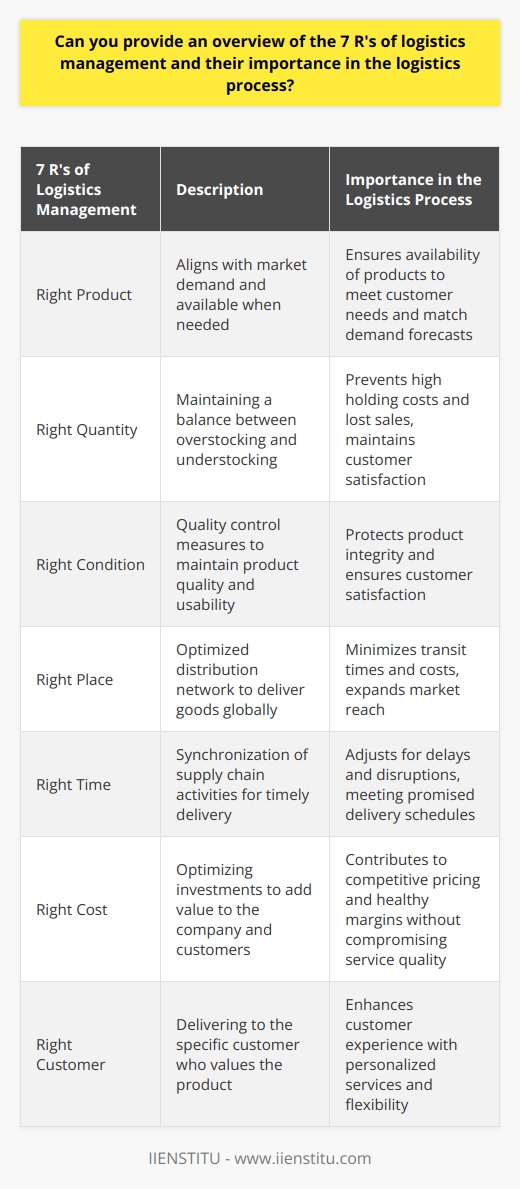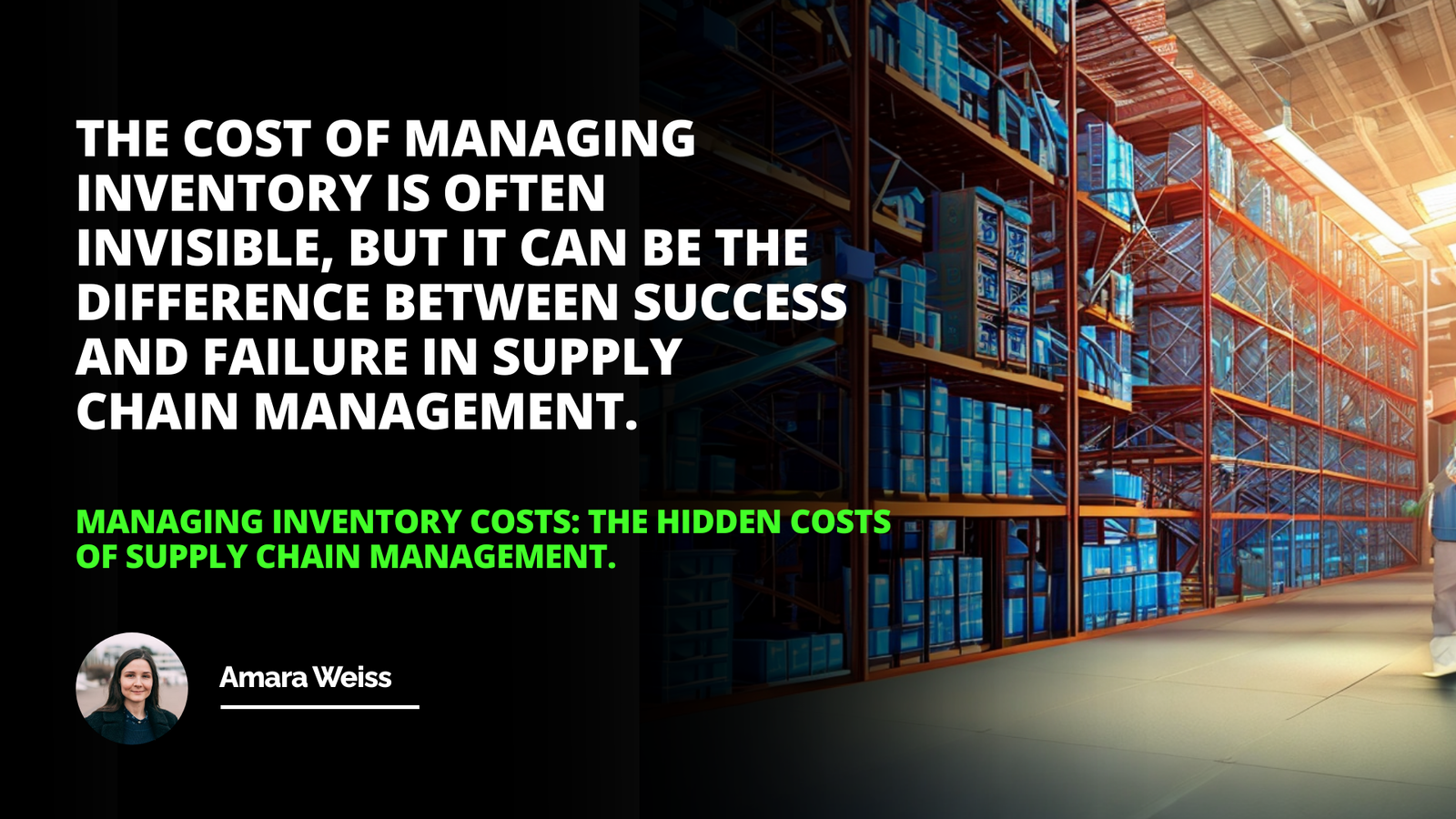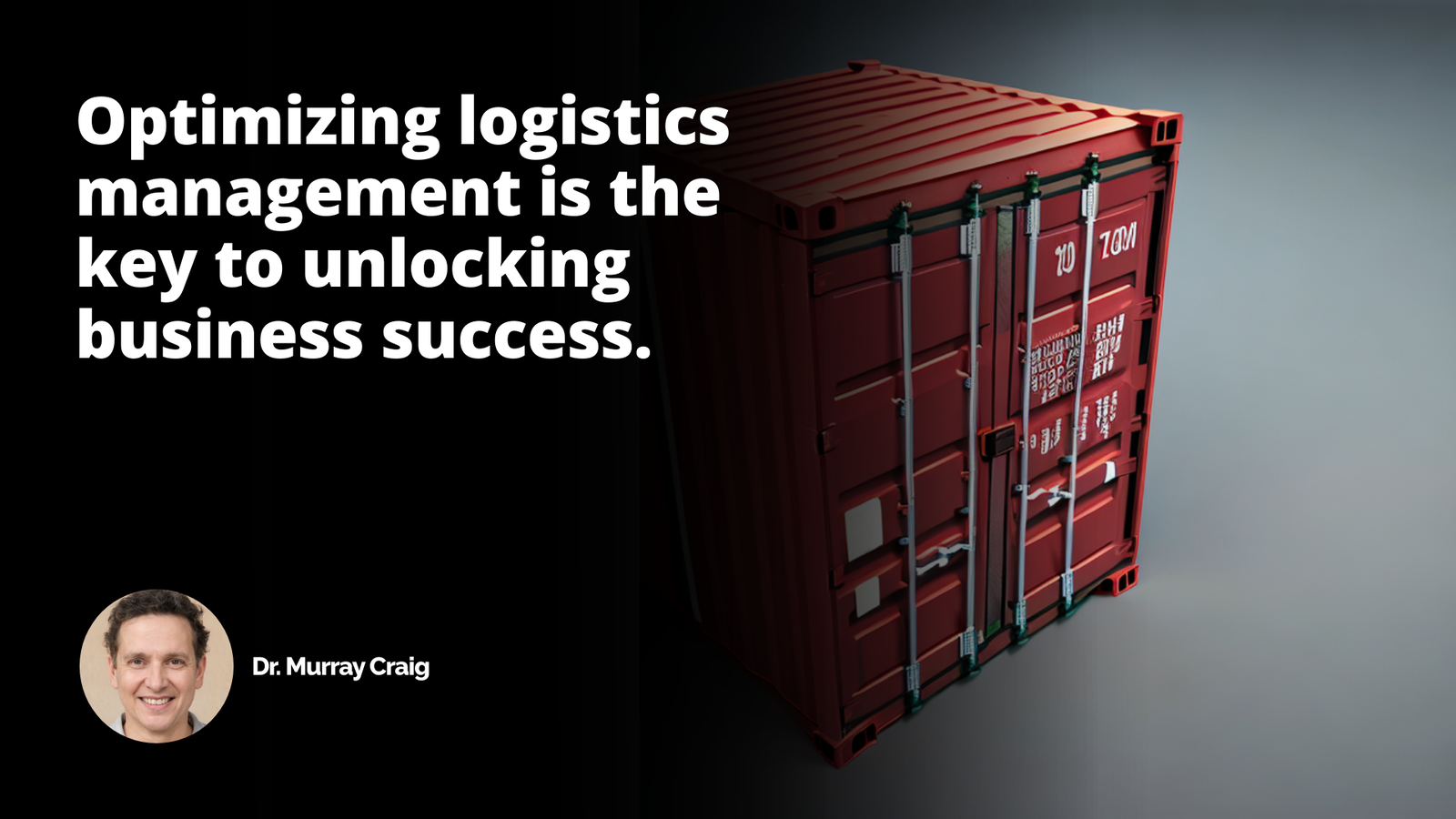
Logistics is an essential part of business operations, referring to the movement of raw materials, products, and finished goods from suppliers to consumers. Logistics management is the process of planning, organizing, and controlling the flow of goods, services, and information between the point of origin and the point of consumption. The main objective of logistics is to ensure the efficient and cost-effective movement of goods and services. In contrast, other purposes include reducing costs, improving customer service, streamlining operations, and increasing efficiency.
Related Course: Logistics Management Courses Online
Introduction
Definition of Logistics
Logistics Management
Objectives of Logistics
Conclusion
Introduction: Logistics is a term that has been used for centuries, but its meaning has evolved. Logistics plays an integral role in business, as it moves raw materials, products, and finished goods from suppliers to consumers. This article will discuss the definition of logistics, logistics management, and logistics objectives.
Definition of Logistics
Logistics is derived from the Greek word logistics and the Latin word logistics, which refer to the science of computing and calculating. Historically, logistics was used in connection with moving armies and supplies of food and armaments to the war front. However, during World War II, logistics gained importance in army operations as a term referencing the movement of supplies, men, and equipment across the border.
In the business world, logistics refers to the movement of raw materials from suppliers to manufacturers and, finally, the movement of finished goods to consumers. It is also referred to as physical distribution. According to Philip Kotler, logistics is “planning, implementing, and controlling the physical flows of materials.”
Logistics Management
Logistics management is the process of planning, organizing, and controlling the flow of goods, services, and information between the point of origin and the point of consumption. It involves coordinating warehousing, transportation, inventory management, packaging, and customer service. Logistics management is essential for companies to ensure the timely and cost-effective delivery of goods and services.
Objectives of Logistics
The main objective of logistics is to ensure the efficient and cost-effective movement of goods and services from the point of origin to the end of consumption. This involves coordinating warehousing, transportation, inventory management, packaging, and customer service. Other logistics objectives include reducing costs, improving customer service, streamlining operations, and increasing efficiency.
Conclusion: Logistics is an essential part of business operations, as it is responsible for moving raw materials, products, and finished goods from suppliers to consumers. Logistics management is the process of planning, organizing, and controlling the flow of goods, services, and information between the point of origin and the point of consumption.
The main objective of logistics is to ensure the efficient and cost-effective movement of goods and services from the point of origin to the end of consumption. Other logistics objectives include reducing costs, improving customer service, streamlining operations, and increasing efficiency.
The key to successful logistics management is to unlock the mysteries of the supply chain.
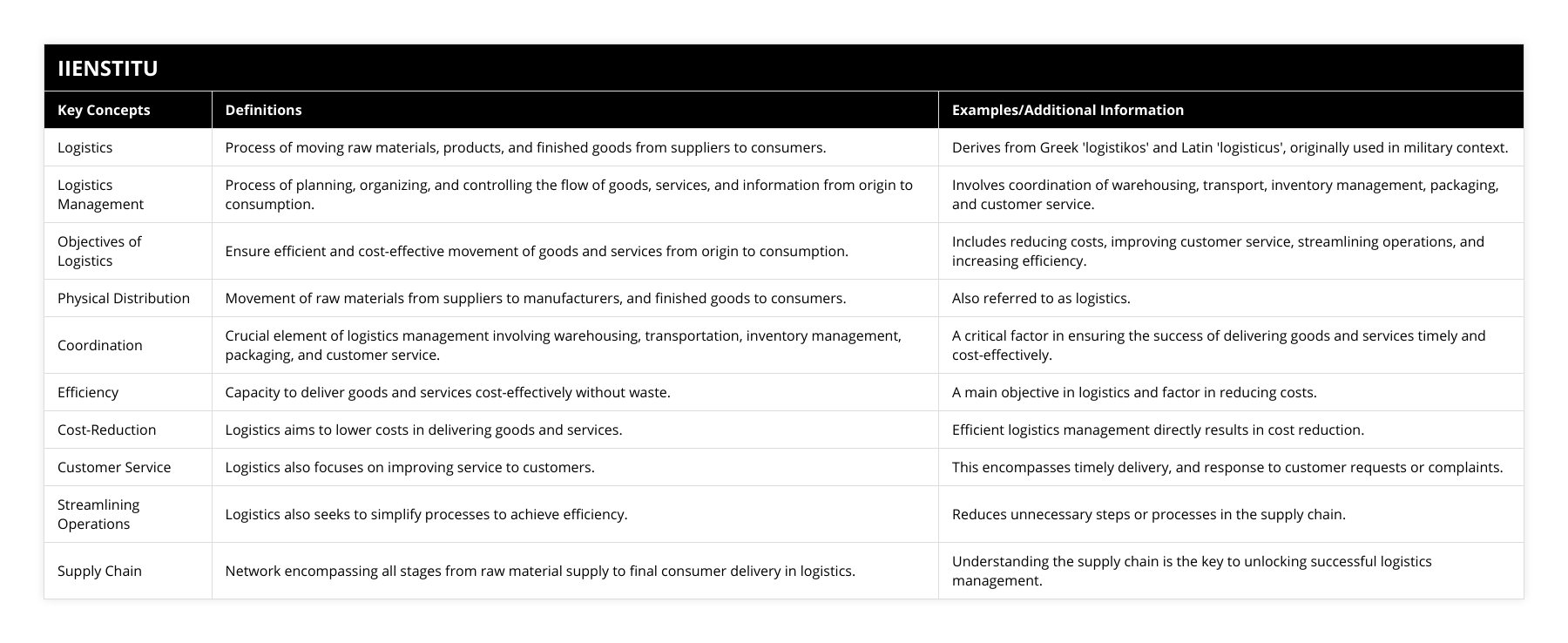
Frequently Asked Questions
What are the key objectives of logistics management?
Logistics management is a critical component of business operations, playing a pivotal role in efficiently delivering goods and services to customers. The objectives of logistics management are to ensure that goods and services are delivered on time and within the budget while meeting customer requirements and expectations. Logistics management also seeks to optimize resources, such as labor, materials, and transportation, to maximize profits.
Successful logistics management requires planning, coordination, and control of the entire supply chain, from procurement and production to delivery and customer service. In addition, logistics managers must be able to develop strategies tailored to their company’s specific needs and goals. To achieve this, they must be able to analyze current and future supply chain trends, assess customer requirements, and forecast demand.
The primary objectives of logistics management are to ensure the efficient and cost-effective movement of products and services from the point of origin to the end of consumption. This includes the timely delivery of goods and services, as well as their safe and secure transport. Logistics managers must also ensure that the supply chain is fast and resilient, as disruption to the supply chain can have serious consequences. Furthermore, they must ensure that customer service levels are maintained and that customer satisfaction is maximized.
Logistics management also seeks to maximize the use of resources, such as labor, materials, and transportation, to optimize profits. This involves optimizing the entire supply chain process, from procurement to delivery. As a result, logistics managers must be able to identify areas where resources can be utilized more efficiently and identify opportunities for cost savings.
In conclusion, logistics management is vital in efficiently delivering goods and services to customers. Its objectives include ensuring timely and cost-effective delivery, maximizing resource utilization, and minimizing disruption to the supply chain. Businesses can optimize profits and ensure customer satisfaction by implementing effective strategies and utilizing resources efficiently.

How can logistics management help to improve supply chain efficiency?
Logistics management is an essential part of supply chain efficiency. Logistics management manages the movement, storage, and distribution of goods to meet customer demands. By optimizing processes and procedures, logistics management can help to improve supply chain efficiency in several ways.
First, logistics management can help to reduce costs associated with the supply chain. For example, the need for manual labor and costly resources can be minimized by streamlining processes and procedures, resulting in lower operational costs. Also, logistics management can help identify and eliminate inefficiencies in the supply chain, such as delays in delivery, incorrect shipments, and wasted inventory. This will help to minimize the cost of poor quality and reduce the overall cost of the supply chain.
Second, logistics management can help to improve customer service. By streamlining processes and procedures, the time it takes to deliver goods to customers can be minimized, resulting in improved customer satisfaction. Also, logistics management can help ensure that customers receive the correct orders on time, resulting in improved customer loyalty and repeat business.
Third, logistics management can help to improve inventory management. The need for large amounts of inventory can be minimized by utilizing inventory management systems, resulting in lower inventory costs and improved cash flow. Also, logistics management can help reduce stock-outs, resulting in lost sales and customer dissatisfaction.
Finally, logistics management can help to improve communication between supply chain partners. By utilizing technology such as tracking systems and visibility platforms, logistics management can help to ensure that all supply chain partners have access to timely and accurate information, resulting in better collaboration and improved efficiency.
Overall, logistics management is an essential part of supply chain efficiency. By optimizing processes and procedures, logistics management can help to reduce costs, improve customer service, improve inventory management, and improve communication between supply chain partners. By leveraging the power of logistics management, organizations can ensure that their supply chains are as efficient as possible.
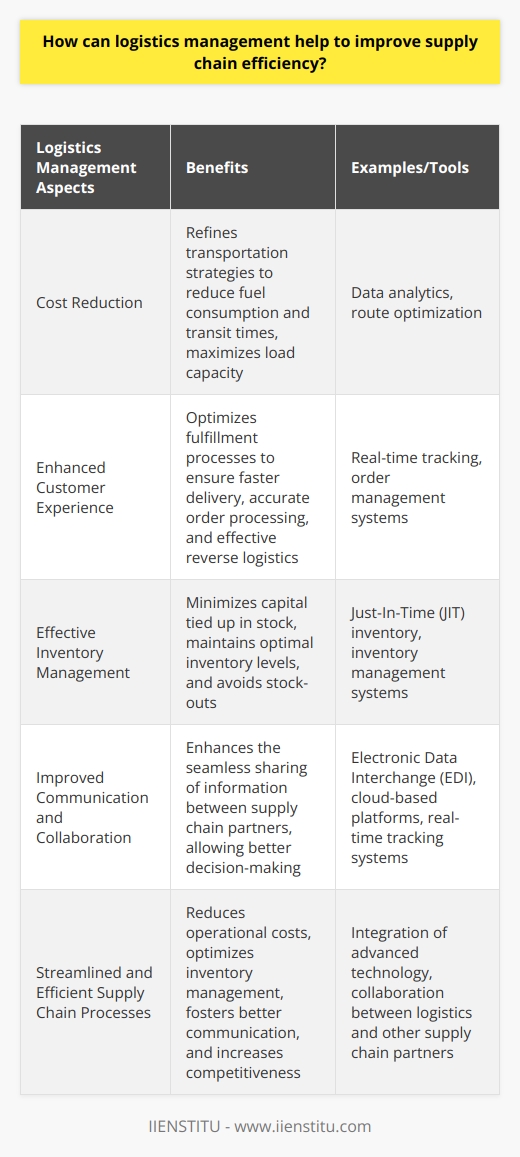
What are the main components of a successful logistics management system?
Logistics management systems are an integral component of operations for many businesses. Therefore, organizations must establish a successful logistics management system to ensure efficient and cost-effective operations. A successful logistics management system consists of several components: a robust supply chain, inventory and warehouse management, transportation management, and performance tracking and reporting.
Supply chain management is the process of planning, implementing, and controlling the efficient flow of goods and services from the source of supply to the point of consumption. Supply chain management involves coordination and collaboration with suppliers, shippers, and other partners to ensure that goods and services reach the consumer efficiently and quickly.
Inventory and warehouse management are also essential components of a successful logistics system. This involves tracking and optimizing the flow of goods and services and ensuring that supplies are available when and where they are needed. Inventory management also consists in guaranteeing that warehouses are appropriately managed and maintained.
Transportation management is another essential component of a successful logistics system. This involves optimizing the flow of goods and services and planning and managing the transportation of goods and services from one place to another. The goal of transportation management is to maximize the efficiency of the transportation process while minimizing costs.
Performance tracking and reporting is the last component of a successful logistics system. This involves collecting and analyzing data related to the performance of the logistics system and reporting this data to management. This allows management to make informed decisions about the design, identify areas of improvement, and take corrective action where necessary.
In conclusion, a successful logistics management system consists of several components: supply chain management, inventory and warehouse management, transportation management, and performance tracking and reporting. As a result, organizations can improve their operations and reduce costs by implementing a well-designed logistics management system.
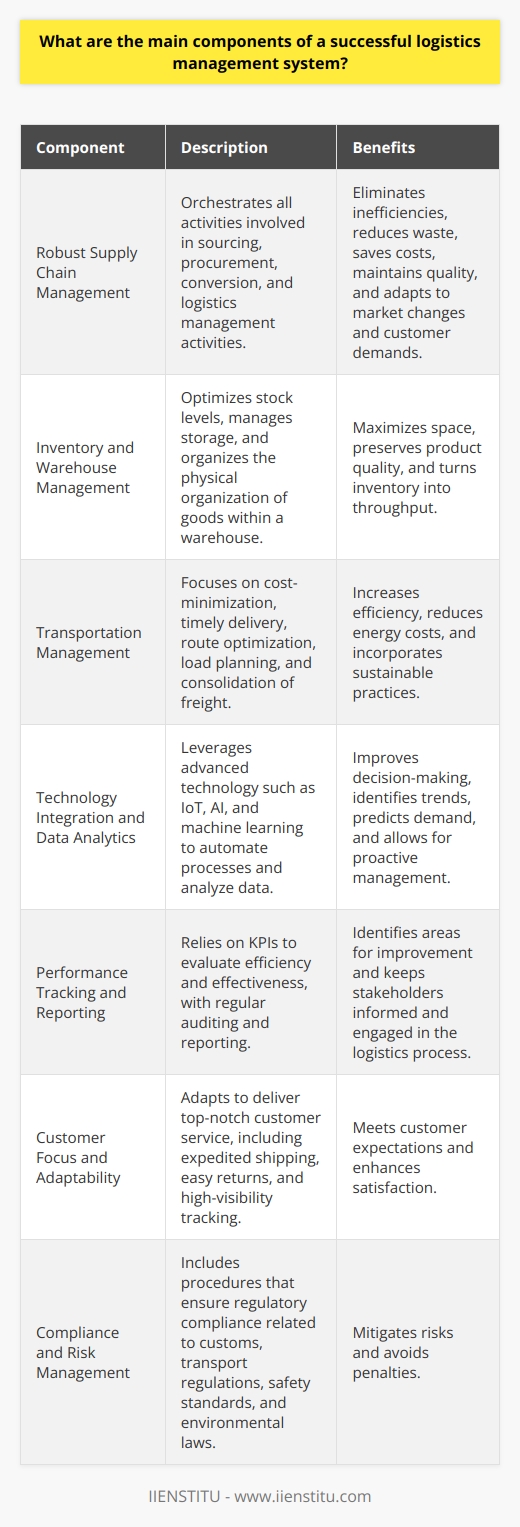
What are the 7 R's of logistics management?
The 7 R's of Logistics Management
Right Product
The first R emphasizes the importance of providing the right product to meet the customer's needs, preferences, and specifications. This entails careful selection, accurate product information, and consistent quality assurance.
Right Quantity
The second R focuses on ensuring the right quantity of products is available to meet customer demand. This requires efficient inventory management, accurate forecasting, and timely replenishment strategies in logistics operations.
Right Condition
The third R emphasizes the need to maintain the right condition of products throughout the supply chain. This includes proper storage, transportation, and handling procedures, which are essential in preserving the quality and integrity of the products.
Right Place
The fourth R highlights the significance of delivering the products to the right place or location. This involves understanding the customer's requirements and planning the most efficient routes and distribution channels for timely and cost-effective delivery.
Right Time
The fifth R emphasizes the importance of delivering products at the right time. This means meeting the customers' expectations regarding order lead time, delivery schedules, and just-in-time production requirements. Effective planning and coordination among supply chain partners is crucial in achieving this objective.
Right Cost
The sixth R underscores the need to manage logistics operations at the right cost. This involves optimizing operational efficiency, reducing wastage and costs throughout the supply chain, and ultimately providing customers with cost-effective solutions that deliver the desired level of satisfaction and value.
Right Customer
Lastly, the seventh R emphasizes the importance of identifying and targeting the right customers to promote mutually beneficial relationships. Successful logistics management requires understanding customer needs, preferences, and buying behaviors and aligning operations to meet these unique requirements effectively.
Overall, the 7 R's of logistics management serve as a holistic framework that guides businesses in achieving operational excellence, customer satisfaction, and competitive advantage in the ever-evolving logistics landscape. By considering these crucial factors in their strategic planning, companies can enhance the efficiency and effectiveness of their logistics operations, ensuring continued growth and success in the market.
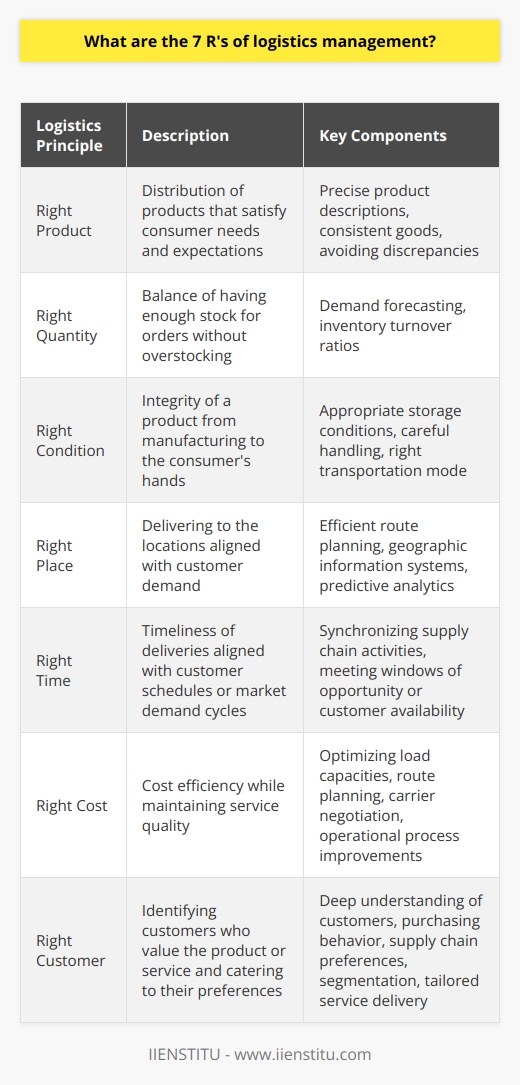
What are the 6 key functional areas of logistics management?
Key Functional Areas in Logistics Management
Supply Chain Planning
The foundational aspect of logistics management is supply chain planning. This involves determining the optimal arrangement of resources, such as inventory, transportation, and storage, to efficiently deliver goods and services.
Transportation Management
Ensuring the timely and cost-effective movement of goods is essential in logistics. Primarily focused on modes of transport and route optimization, transportation management guarantees the realization of supply and demand in a well-coordinated manner.
Inventory Control
Effective inventory control balances the availability of products and services with the minimization of holding, carrying, and obsolescence costs. This functional area falls under materials management and involves decision-making on optimal levels, location, handling, and tracking of stocks throughout the supply chain.
Warehouse and Storage Management
Efficient utilization of storage space and proper handling of goods are key factors in the warehouse and storage management. This area includes layout design, materials handling systems, storage and retrieval policies, and technology integration to ensure organized and streamlined operations.
Order Fulfillment
This functional area is vital to ensure customer satisfaction. Order fulfillment handles order processing, picking, packing, shipping, and tracking of deliveries to meet customer expectations while minimizing lead times and operational costs.
Information Management
Effective logistics management requires the seamless sharing and analysis of data and information among supply chain partners. This area includes the use of technology and systems to monitor, control, and manage the flow of critical information to support decision-making and continuous improvement.
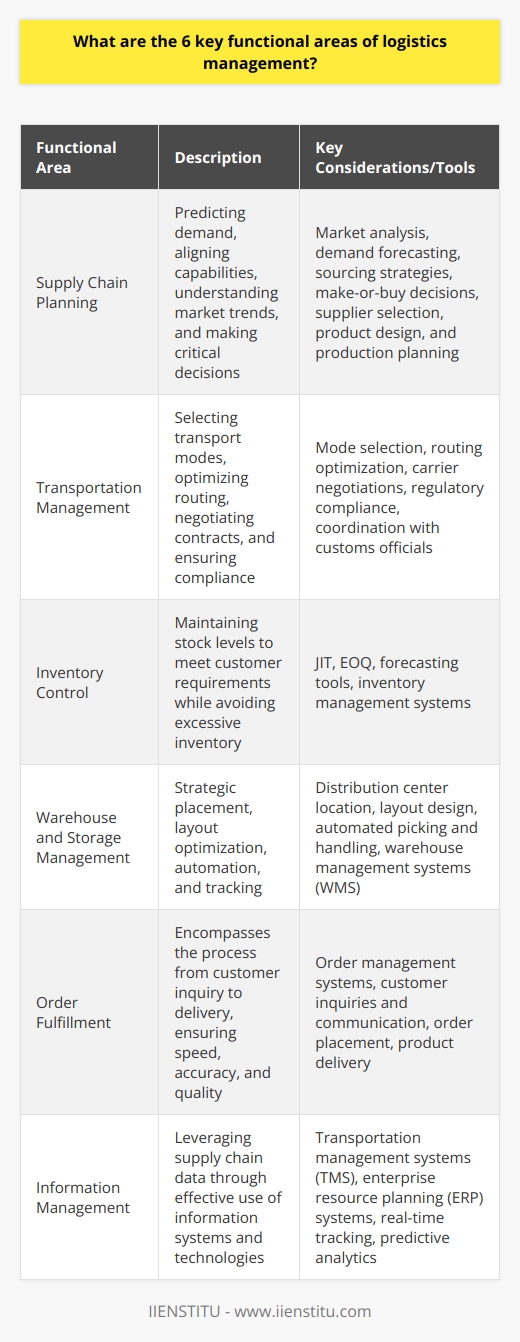
What are the 5 logistics strategies?
Effective Logistics Strategies
Five primary logistics strategies have proven to be effective in optimizing the supply chain management process. These strategies include (1) lean logistics, (2) agile logistics, (3) demand-driven logistics, (4) customer-focused logistics, and (5) risk management logistics.
Lean Logistics
Lean logistics focuses on streamlining and minimizing waste, while increasing operational efficiency in the supply chain. It involves optimizing inventory levels, implementing Just-In-Time (JIT) delivery, and utilizing continuous improvement methodologies such as Six Sigma and Kaizen, resulting in cost reductions and improved customer satisfaction.
Agile Logistics
Agile logistics emphasizes the ability to adapt and react quickly to market changes and disruptions. This strategy involves flexible supply chains, enhanced information sharing, and collaborative relationships with suppliers, enabling companies to quickly respond to fluctuating demand, reduce lead times, and increase overall competitiveness.
Demand-Driven Logistics
Demand-driven logistics centers on accurate demand forecasting and real-time data to ensure the efficient and timely delivery of products to customers. By integrating demand signals from various sources, such as point-of-sale data and marketing promotions, businesses can better manage inventory, minimize stockouts, and improve customer satisfaction levels.
Customer-Focused Logistics
Customer-focused logistics prioritizes the delivery of superior service and tailored solutions to meet individual customer needs. This strategy involves investing in advanced information technology and systems, enhancing delivery capabilities, and developing customized service offerings to provide a seamless, end-to-end customer experience, ultimately driving loyalty and repeat business.
Risk Management Logistics
Risk management logistics involves the identification, assessment, and mitigation of potential threats and vulnerabilities within the supply chain. Firms employing this strategy implement robust contingency plans, conduct regular audits of suppliers, and utilize advanced analytics and monitoring tools to minimize disruptions, ensure business continuity, and safeguard company reputation.
By adopting and integrating these five logistics strategies, organizations can optimize their supply chain operations, maximize efficiency, boost customer satisfaction, and ultimately, achieve a competitive advantage in today's ever-evolving business landscape.
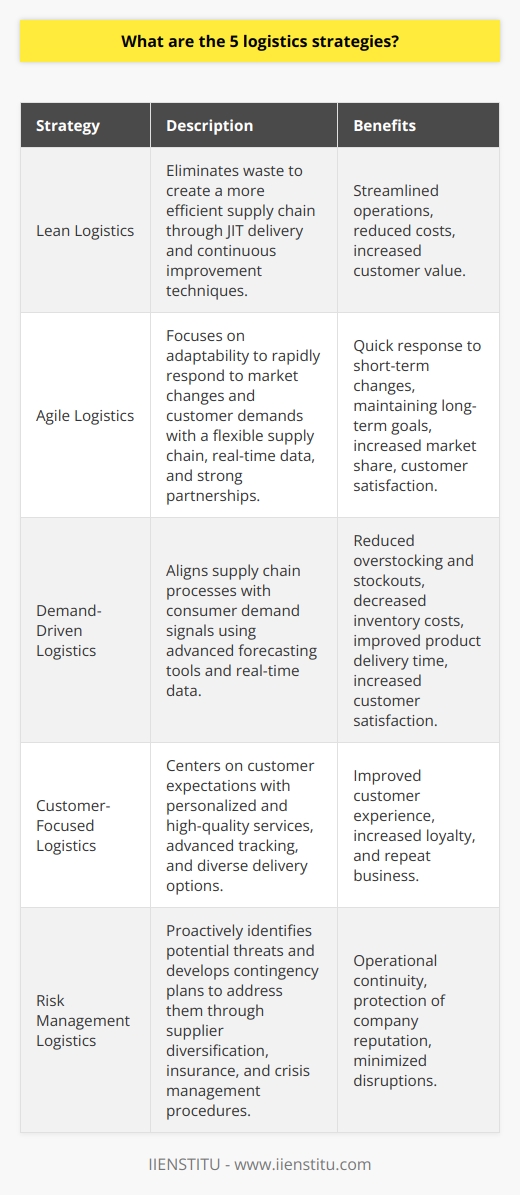
What are the 4 areas of logistics management?
4 Key Areas of Logistics Management
Transportation Management
Transportation management is a crucial component of logistics management, involving the selection of the most efficient and cost-effective modes of transportation for the movement of goods. This encompasses planning, organizing, and controlling functions such as route optimization, carrier selection, vehicle utilization, and load planning. The primary goal of transportation management is to streamline processes in order to ensure timely delivery of products while minimizing costs.
Inventory Management
Inventory management is another essential area of logistics management that focuses on maintaining the right amount of stock to meet customer needs and minimize carrying costs. This includes forecasting demand, determining reorder points, managing safety stock, and monitoring stock levels. Effective inventory management ensures that the supply chain operates smoothly and reduces the risk of stockouts or excess inventory, both of which can have adverse effects on a company's profitability.
Warehouse Management
Warehouse management involves the efficient and effective storage of goods in a manner that optimizes space utilization and accessibility. This area of logistics management encompasses activities such as inventory tracking, material handling, order picking, packaging, and shipping. Proper warehouse management is essential for ensuring the speedy processing and fulfillment of customer orders, and can also contribute to a reduction in overall logistics costs.
Order Management
Order management is the logistics management process that oversees the activities related to receiving, processing, and ultimately fulfilling customer orders. It begins with capturing customer order data and ends with the delivery of their purchased products. Accurate and efficient order management helps reduce lead times, increase order accuracy, and ensure on-time delivery. Additionally, an effective order management system can contribute to improved customer satisfaction and enhanced supply chain visibility.
In conclusion, the four key areas of logistics management, comprised of transportation management, inventory management, warehouse management, and order management, are vital to the efficient and effective operation of a company's supply chain. These areas of logistics management work in concert to streamline the flow of goods from the point of origin to the point of consumption. Proper management of these areas results in increased customer satisfaction, reduced overall costs, and enhanced competitiveness in the marketplace.

How do the 5 logistics strategies support supply chain performance?
Logistics Strategy Integration
The integration of the five logistics strategies - customer service, transportation, inventory control, procurement, and warehousing - significantly enhances supply chain performance. Each strategy contributes to the overall effectiveness and efficiency of the supply chain, enabling organizations to meet customer demands while minimizing costs.
Customer Service Excellence
A focus on customer service helps support supply chain performance by ensuring customer needs are met promptly and accurately. This strategy involves understanding customer preferences and requirements, enabling companies to tailor their product offerings and services accordingly, and increase overall customer satisfaction. In turn, this satisfaction ensures customer loyalty and repeat business, which directly impacts a company's bottom line.
Optimized Transportation Management
Transportation is a critical component of supply chain management as it involves the movement of goods from one location to another. Efficient transportation strategies facilitate the timely and cost-effective delivery of products to customers, while minimizing the risk of damage or loss. Optimizing transportation management helps reduce overall supply chain costs, as well as enhancing its reliability and resilience, ultimately contributing to improved organizational performance.
Inventory Control Effectiveness
Effective inventory control ensures that organizations have the right products available at the right time to meet customer demands. This strategy involves accurate forecasting, proper stock replenishment, and efficient utilization of warehouse space. By minimizing stockouts, overstocking, and obsolescence, companies can reduce costs and enhance customer satisfaction.
Streamlined Procurement Processes
An efficient procurement strategy is crucial for supply chain performance as it directly affects the cost and availability of raw materials and finished goods. By implementing a streamlined process that includes supplier relationship management, contract negotiation, and quality assurance, organizations can minimize procurement delays and discrepancies, reduce costs, and ensure the timely availability of required materials, ultimately contributing to a more effective supply chain.
Warehousing Efficiency
Efficient warehousing involves the optimal storage and handling of products to ensure their timely retrieval for customer orders. By implementing strategies such as space optimization, warehouse automation, and effective inventory management, companies can minimize retrieval time and storage costs while maintaining high order accuracy rates. This efficiency contributes to enhanced customer service levels and overall supply chain performance.
In conclusion, the five logistics strategies play a vital role in supporting supply chain performance by ensuring timely and cost-effective product availability, enhancing customer satisfaction, and minimizing operational costs. By implementing these strategies in a cohesive manner, companies can optimize their supply chain management, thus improving overall organizational performance.
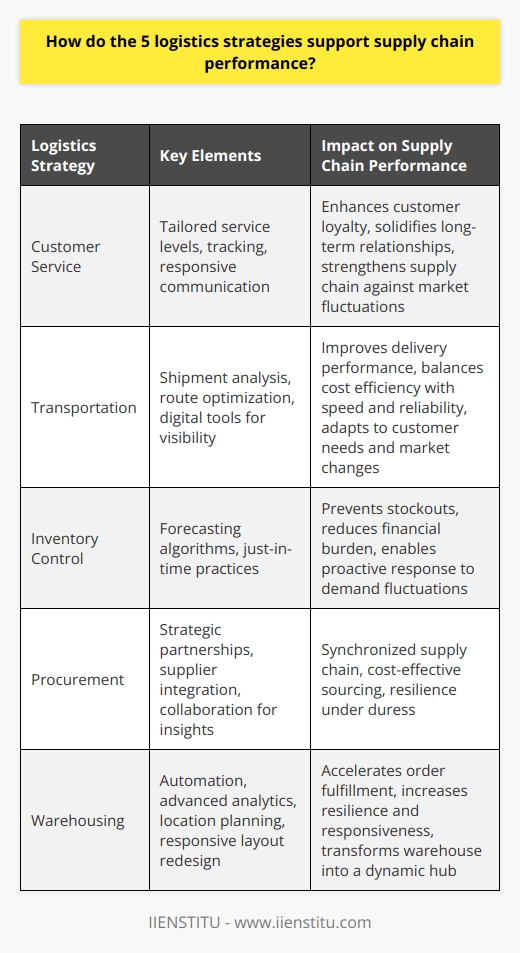
Can you provide an overview of the 7 R's of logistics management and their importance in the logistics process?
Overview of the 7 R's
Logistics management plays a crucial role in ensuring the efficient flow of goods and services throughout a supply chain. The 7 R's of logistics management can be understood as the set of guiding principles for achieving these goals. They significantly help in streamlining the logistics process, reducing costs, and improving overall efficiency.
Right Product
The first principle states that the correct product should be sent to the appropriate place. This requires accurate comprehension of the customer's needs and thorough planning to ensure a smooth and effective supply chain. Inventory management and procurement play significant roles in fulfilling this requirement.
Right Quantity
Maintaining the optimal amount of products in stock is critical for meeting customer demands. Proper forecasting and inventory control ensure that there is no shortage or overstocking of goods. A well-managed stock level can minimize costs and increase the effectiveness of the supply chain.
Right Condition
The condition of the product is of utmost importance. Damaged or defective items can lead to dissatisfied customers and potential losses. Therefore, logistics managers must implement effective strategies to handle, store, and transport goods to maintain their quality and integrity.
Right Place
Having the required product accessible in the correct location is essential for successfully serving customers. Logistics managers must work closely with suppliers, manufacturers, and retailers to ensure optimal distribution network design. This includes the selection of appropriate transportation modes and route optimization to minimize costs and delays.
Right Time
Delivering products on time is a crucial aspect of meeting customer expectations. Timely delivery involves proper planning, scheduling, tracking, and monitoring of shipments. Logistics managers need to work closely with suppliers and transporters to ensure that goods reach their destination promptly.
Right Cost
Efficient management of logistics resources leads to cost savings which benefit the entire supply chain. Competitive pricing is possible by identifying and controlling expenses related to transport, warehousing, and labor. The focus should be on maintaining a balance between quality of service and the cost incurred.
Right Customer
The final principle emphasizes the importance of ensuring that products reach their intended customers. Logistics processes should be customer-centric and designed to provide maximum value. This involves understanding customers' preferences, establishing effective communication channels, and building strong relationships with them.
In conclusion, the 7 R's of logistics management offer a comprehensive framework for optimizing the logistics process. By ensuring the right product, in the right quantity, condition, place, time, cost, and for the right customer, logistics managers can create efficient supply chains that meet customer demands and contribute to overall business success.
